For four months, Turin will be dressed in the lights, colors and suggestions of the rising sun.
From 23 February to 25 June 2023, the Turin Fine Arts Promoter Society hosts the exhibition Utamaro, Hokusai, Hiroshige. Geishas, samurai and the civilization of pleasure.
The exhibition, curated by Francesco Paolo Campione, director of MUSEC – Museum of Cultures of Lugano, produced by Skira, in collaboration with MUSEC and with the Turin Fine Arts Promoting Society, under the patronage of the Municipality of Turin, analyzes the Japanese universe through a thematic itinerary, divided into nine sections, with over 300 masterpieces, some of which have never been presented in Italy: prints by the greatest masters ofukiyo-ewhich Hokusai, Hiroshige, Utamaro, Kunisada, Yoshitoshi, Sharaku, as well as samurai armor, kimonos, theater masks, rare printing plates, precious female ornaments, stone sculptures, bannerscoming from the collections of MUSEC in Lugano, the Museum of Oriental Art in Venice, the Museum of Oriental Art in Turin, the Civic Museum of Oriental Art in Trieste, the Fondation Baur Musée des Arts d’Extrême-Orient in Geneva and important private collections.
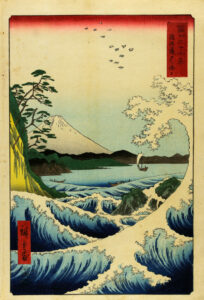
The exhibition is proposed as an original reconstruction, in all its aspects, of the “civilization of pleasure”, a peculiar historical-artistic season of Japan – the Edo period (1603-1868) – in which the country, pacified within the own borders and strict in a policy of isolation from the rest of the world (sakoku), brought the wealthy merchant class (chonin), unable to buy landed goods, to devote themselves to the pleasures of existence, such as the shows of kabukifrequenting geishas in teahouses and buying extraordinary works of art.
“Skira returns to Turin – underlines Massimo Vitta Zelman, President of Skira Editore -, one of the key squares of its intense exhibition activity, and does so with a new, great tribute to Japanese art and universe. Images of the “floating world“, nature in its most scenic aspect, the civilization of pleasure: a new, extraordinary opportunity for the Italian public and for tourists who fortunately return to crowd our country to immerse themselves in the magic of the Japanese universe and of that iconographic culture which has also exerted so much fascination on Western art. An opportunity that, we are sure, will not be lost”.
The exhibition itinerary opens with the “images of the floating world” (ukiyo-e)xylographic prints made on wooden matrices that became synonymous with “modern”, fashionable, and ended up expressing a sort of philosophy centered on the taste for a pleasant existence and, as far as possible, satisfying personal desires, interpreted by artists such as Hiroshige, Utamaro, Kunisada, Hokusai; of the latter, the review presents the fifteen volumes of Manga, a true drawing encyclopedia, in which the Japanese artist portrays everything he has seen or that his mind has conceived, from landscapes to natural and supernatural elements, from daily life to human beings and divinities, from flora to fauna.
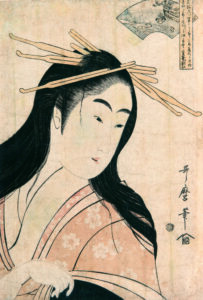
“The ukiyo-e art movement – says Francesco Paolo Campione, curator of the exhibition – was the real axis of the diffusion of the new ideals of the bourgeois classes which above all produced an enormous quantity of woodcut prints, together with a genre painting (nikhitsuga) far from the cultured figurative languages of realist painting (shadei-ga), of Western-style painting (yōfūga) and of the contemporary Tosa and Kanō Schools”.
“Coming to the main themes of ukiyo-e – continues Francesco Paolo Campione – it should first of all be emphasized that, during its first phase, the artists were above all attracted by the world of theater kabukifrom the beauty of the women who populated the pleasure districts and from the representation of the erotic scenes”.
The exhibition continues with the reconnaissance on the typical subjects of Japanese art, such as that of nature seen both in its more landscaped aspect, interpreted for example by stamped by Hiroshigeboth in what was recognized and real pictorial genre of “flowers and birds” (cashohga) which, in their symbolic juxtapositions, also act as signs of the seasons. The sparrows with the winter camellias flowering in the snow symbolize the incipient spring which in the traditional calendar fell between January and February; cherry blossoms (sakura) are typical of late spring; the peonies (Botan) and irises signal summer; the bluebells (kikyo), finally, are characteristic of autumn.
Ephemeral pleasures were also among the most documented subjects in Japanese prints; like that of the theater kabuki, the popular show par excellence. In Turin it will be possible to admire the prints depicting the actors of these performances. They are works with elegant and refined traits which, over time, underwent a peculiar evolution: from the “primitive” works of the XVII and XVIII century aimed above all at outlining the physiognomy of the actors and their stage accessories, to the very colourful, rich and hyper- expressive multi-sheet compositions of the end of the Edo period, in which the artists try to reproduce all the scenic richness.
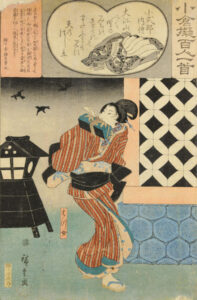
In this section you will also find an official program of 1890 illustrated and printed in black with a woodblock matrix, uno banner (nobori hata) of the middle of nineteenth century in hand-painted fabric, used as an advertising sign for theater shows kabuki, as well as over 30 folk and theater masks noh and of the theatre kyohgen.
Particularly interesting is the figure of the artist Sharaku, on whose identity speculation is wasted; there are those who think he was an actor, those who favor a pseudonym used by a group of highly innovative artists and those who argue that Hokusai is hidden behind his name. Beyond all conjecture, the faces of the theater actors kabuki portrayed in Sharaku’s works allowed to interpret the psychology of the characters brought on stage and revealed a temporary emotion raised to a spiritual level and, sometimes, the very essence of a personality.
Also the female universe was deeply investigated; while on the one hand the aspects of the daily life of women of various ages, of different ages and social backgrounds were explored, such as in the prints of Tsukioka Yoshitoshi o nei trittici di Miyagawa Shuntei who portrayed women engaged in typical activities flanked by plant elements to recall the various months of the year, on the other, erotic woodcuts (that’s it) they established themselves as a genre of primary importance; they were made by the most important artists of the time. In their works we find a direct testimony and a personal emotional participation in the representation of the pleasures of sexuality, enriched by the knowledge and by the quotation, sometimes even philological, of a literary production full of sensuality.
They will be exhibited in Turin over fifty masterpieces of erotic artbetween prints and shunpon, books of polychrome woodblock prints, whose illustrations referred to the idea of the sacredness of the sexual act and to a rich mythology.
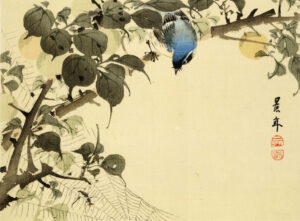
Among these, we note the series of 12 woodcuts Images of love for twelve monthsthe most important of the erotic works di Katsukawa Shunchō in which each scene presents a series of visual elements (objects, trees, animals) and quotations reported in the calligraphies that allow the prints to be assigned to the different months of the year to which they are connected; or Erotic introduction to marriage di Utagawa Kunisadaan artist considered among the best of his time and enjoyed great fortune, or the rare series of twelve polychrome woodcuts Making love to a woman of immense beauty by Kitagawa Utamaro, unequaled master of eroticism. The book is one of the peaks achieved by the genre that’s it and, by far, one of the most complete expressions of the longed-for style of ineffable perfection that denotes the aesthetic research of the floating world and its conception of pleasure.
The exhibition continues with the section documenting the prints depicting warriors and heroes of the Japanese tradition (village-e). These owe their typical appearance to the work of Utagawa Kuniyoshi (1798-1861) who, starting in 1827, devoted much of his attention to them. His characters are dressed in splendid clothes and portrayed as they fight or perform heroic gestures, facing enemies and monstrous beings represented with extraordinary detail, in a lively landscape full of descriptive details.
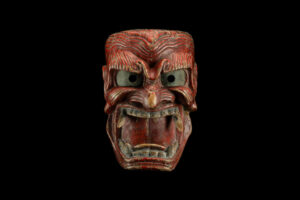
The so-called will also be exhibited warrior books by Hokusaitrue drawing masterpieces in which the artist moves between nature and the supernatural, placing the action of the hero at the center of his figurative research.
The exhibition closes with a room dedicated to the iconographic and stylistic heritage of theukiyo-ewith a spectacular immersive installation that introduces the vision of Big Wave by Hokusai which, on the one hand, summarizes in an image the sense of transience and provisional nature of human life in the face of the unstoppable force of nature and history, on the other, expresses the desire not to heroically oppose the facts of life, but to let go, guided by an existential philosophy based on pleasure.
UTAMARO, HOKUSAI, HIROSHIGE. GEISHA, SAMURAI and the civilization of pleasure
Turin, Promoting Society of Fine Arts (viale Diego Balsamo Crivelli, 11)
23 February – 25 June 2023
